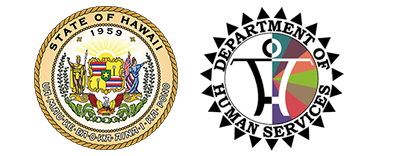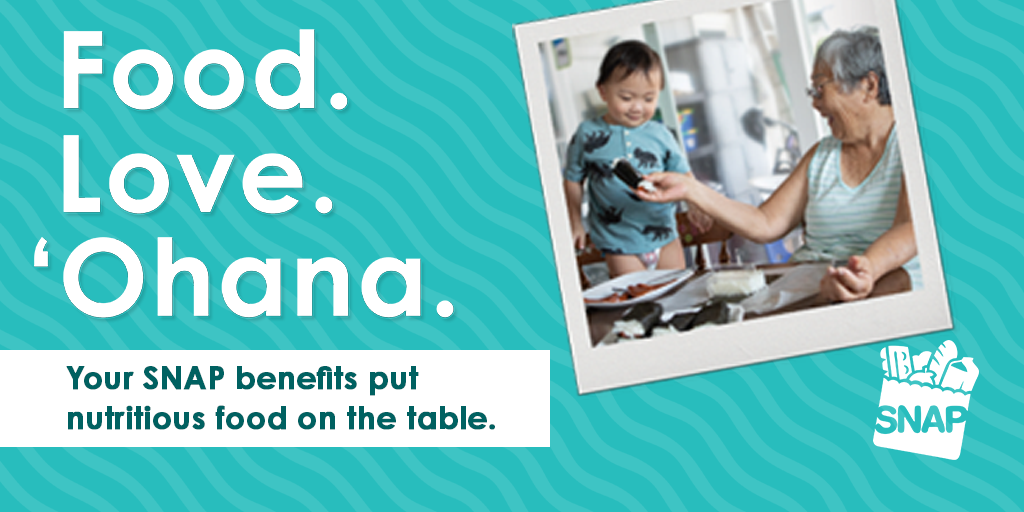SUPPLEMENTAL NUTRITION ASSISTANCE PROGRAM (SNAP)
For more information call Public Assistance Toll Free Information Line at 1-855-643-1643.
The Supplemental Nutrition Assistance Program (SNAP) is a federal program funded through the U.S. Department of Agriculture (USDA) and administered at the federal level through its Food and Nutrition Service (FNS). State agencies administer the program at the state and local levels, including determination of eligibility and monthly allotments. In Hawaii, this service is provided by the Department of Human Services (DHS) Benefit, Employment & Support Services Division (BESSD).
What is SNAP?
The SNAP program provides crucial food and nutritional support to qualifying low-income and needy households, and those making the transition from welfare to self-sufficiency. In FY 2014, SNAP helped put food on the table for an estimated 193,565 Hawaii residents (98,440 families).
The Hawaii Electronic Benefit Transfer (EBT) Program
The Hawaii Electronic Benefit Transfer (HI/EBT) system processes financial assistance benefits provided by BESSD. Payments distributed through this system are for the Temporary Assistance for Needy Families (TANF), Temporary Assistance for Other Needy Families (TAONF), General Assistance (GA), Aid to the Aged, Blind or Disabled (AABD), Repatriates, Childcare, Employment and Training (E & T), First-To-Work (FTW) and the SNAP programs.
Clients use an EBT debit card to access their cash and/or SNAP benefits at authorized food retailers through their Point of Sale (POS) machines and Automated Teller Machines (ATMs). Allpoint® – Global Surcharge-Free ATM Networks are located across the state. Visit this website to find the system nearest to you.
Recipients receiving cash assistance may also choose to have their cash benefits directly deposited into their personal bank accounts.
Who is Eligible to Receive SNAP?
Households must meet specific eligibility requirements and provide proof of their statements about household circumstances. U.S. citizens and some aliens who are admitted for permanent residency may qualify. Federal poverty guidelines are established by the Office of Management and Budget, and are updated annually by the Department of Health and Human Services.
What is the SNAP Application Process?
SNAP BENEFITS and FINANCIAL ASSISTANCE APPLICATION – SNAP RECERTIFICATION click here
(Multi-language access is available)
When you submit your application, you will receive a receipt with your tracking number. This means we have received your application. DHS will contact you for your interview.
Due to the increase in applications and the subsequent workload at Processing Centers, there may be delays in processing and replies to voice mails. Providing you with timely service is very important to us.
There are 3 ways to submit your application:
- Apply online using the new ONLINE APPLICATION
- U.S Postal Mail – *paper form
- Drop off – *paper form
*Paper form – Once complete, you may print and sign the form, then mail it, or drop it off at a processing center as noted above.
WHAT HAPPENS WHEN I APPLY FOR BENEFITS [updated July 2020] – (click here)
Current Recipients of SNAP:
The paper application form is also available for pick up from all State processing centers. After you have filled out the application and gathered all required paperwork to verify your information, you may visit the processing center closest to your residence.
Click here to view the location of Processing Centers.
An intake worker will review your completed application package to determine if you qualify for SNAP benefits. If you are eligible, the worker will assign you to one of three eligibility standards, based on your family’s unique situation. The federal poverty guidelines (FPL) listed below will help you to determine if your monthly income exceeds SNAP eligibility criteria. If your income exceed the criteria, you will not be eligible for SNAP assistance.
FRAUD ALERT
USDA Warns of Text Scam Targeting SNAP Recipients – click here for more information (9/10/20)
*** This Federal Poverty Limit (FPL) chart is for reference only. An intake worker will make the final determination of your eligibility category.
SNAP Gross Monthly Income Eligibility Standards (Effective 10/1/2024)
| Household Size |
130% Federal Poverty Level |
200% Federal Poverty Level (BBCE) |
|
1 |
$1,876 |
$2,886 |
|
2 |
$2,546 |
$3,918 |
|
3 |
$3,217 |
$4,950 |
|
4 |
$3,887 |
$5,980 |
|
5 |
$4,558 |
$7,012 |
|
6 |
$5,229 |
$8,044 |
|
7 |
$5,899 |
$9,076 |
| 8 | $6,570 |
$10,108 |
|
Each additional member |
+$671 |
+$1,032 |
SNAP Net Monthly Income Eligibility Standards (Effective 10/1/2024)
|
Household Size |
100% Federal Poverty Level |
|
1 |
$1,443 |
|
2 |
$1,959 |
|
3 |
$2,475 |
|
4 |
$2,990 |
|
5 |
$3,506 |
|
6 |
$4,022 |
|
7 |
$4,538 |
| 8 |
$5,054 |
|
Each additional member |
+$516 |
Other eligibility criteria include:
- Broad-Based Categorical Eligibility (BBCE) expands SNAP benefits to low-income families with high expenses, and to families whose gross incomes are slightly higher than the 130% FPL normal gross income test. Under BBCE, the gross income limit is 200% FPL and there is an unlimited asset standard. As of February 1, 2025, under BBCE households are also not subject to the net income test. Most households qualify for BBCE after they are provided with a copy of the DHS 1464 (TANF Brochure Rev. 04-2022). However, if a household member has been disqualified under SNAP, it may not qualify for BBCE.
- Households where all members receive, or are authorized to receive TANF or SSI cash assistance, are categorically eligible for SNAP. There is no gross income limit, no net income limit and no asset limit.
- Net monthly income must be 100 percent or less of the Federal poverty guidelines. Net income is figured by adding all of a household’s gross income, and then taking a number of approved deductions for child care, extra shelter costs and other expenses. Households with an elderly or disabled member are subject only to the net income test.
- Most able-bodied adult applicants must meet certain work requirements.
- All household members must provide a Social Security number or apply for one.
Monthly Application Timeliness Rates FFY 2025 (Updated Monthly)
Monthly Participation Rates SFY 2025 (Updated Monthly)
ARCHIVE – SNAP Monthly Participation Rates
ARCHIVE – SNAP Application Timeliness
Other Information
FFY 2025 Approved Employment and Training (E&T) State Plan
Hawaii Financial and SNAP Benefits – Rights and Responsibilities
Hawaii Electronic Benefit Transfer (EBT) Program

